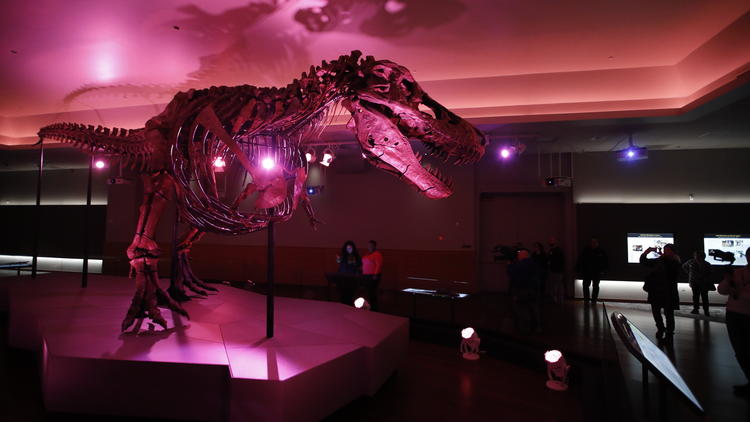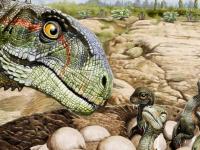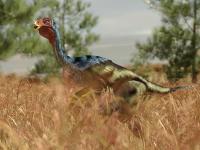Scotty vs. Sue: Is The Canadian T. Rex Really Bigger Than Chicago's? The Field Museum Disputes New Study

If a new study is correct, Sue, the Field Museum’s iconic T. rex and one of the world’s great natural history artifacts, has been surpassed and Chicago will now have to accept Second City status in apex predator skeletons too.
Billed by the museum as the world’s largest and most complete T. rex ever found, Sue is smaller in size and weight than Scotty, a T. rex from Saskatchewan, according to a new paper by a team led by Canadian scientists and published in the journal The Anatomical Record.
The specimen was first discovered 28 years ago and was known to be a large T. rex, but the paper, years in the making, is the first full scientific description of it, and the first to specify the “largest” size.
Headlines in both the scientific and popular press hailed the news. “Paleontologists discover 'Scotty,' the world's largest T. rex fossil: 'The rex of rexes',” said USA Today’s.
But hold on a minute, says the Field, which has made Sue a centerpiece of its collection since 2000 and just last December unveiled a new gallery designed especially for the 40-plus-foot-long, 90 percent-intact skeleton discovered in 1990 in the Black Hills of South Dakota.
“It's sort of a tempest in a tea cup,” said Pete Makovicky, the Chicago museum’s lead curator of dinosaurs, when asked about the headlines tagging Scotty as the new size king. “When you look at it scientifically, you know, the two specimens are about the same size — or, we can say, statistically indistinguishable.”
In other words, the most you can say about Sue vs. Scotty is that we now have two very large, very long-lived T. rexes, argued Makovicky, because of certain imprecisions in measuring fossils and extrapolating the weight of a flesh-and-blood animal from bones that have turned to stone.
Also, he added, there’s a third big T. rex specimen at Museum of the Rockies in Montana that should be part of this grouping, too, since it has about the same femoral, or thigh-bone, circumference as the other two animals, a key measurement in estimating mass.
What’s most meaningful, scientifically, about Scotty’s size isn’t so much any superlative but the fact that we now have three T. rex specimens of about the same size, suggesting that the 40- to 42-foot-long and 20,000-pound range may have been the species’ topping-out point.
“We're basically extending the range of what we know about T. rex,” said Ryan McKellar, curator of paleontology at the Royal Saskatchewan Museum, which has a Scotty skeleton cast on display at its T. Rex Discovery Centre in Eastend, near where Scotty was found, and in May will unveil a second Scotty replica at its main museum in the capital city of Regina. “It gives us a more complete idea of how big these guys got.”
Scotty, like Sue, also exhibited significant evidence of injury on its bones, reinforcing the idea that T. rexes had to endure a lot to make it to maturity when they were alive some 67 million years ago.
But the public loves to know which is biggest, best or otherwise the most. So do the people who market museums to potential visitors facing scores of entertainment choices: “Our collection is home to the world's most massive T. rex skeleton,” the website for the Royal Saskatchewan Museum says already. And so even do all but the most dispassionate scientists.
“It is certainly a thrill to stand next to the specimen, to hold it in your hand, and know that you're looking at what is currently, at least, the largest known terrestrial carnivore of all time,” said Scott Persons, a dinosaur paleontologist at the University of Alberta, the neighboring province of Saskatchewan, which is essentially north of Montana.
Persons is talking here about Scotty, the skeleton discovered by a high school science teacher in 1991 and named after the liquor the teacher and the RSM paleontologists he was with drank to celebrate finding it. It took so long to fully excavate the bones, separate them from stone and properly measure them because they were in sandstone that was particularly dense due to its high iron content, Persons said.
Persons was lead author of “An Older and Exceptionally Large Adult Specimen of Tyrannosaurus rex,” the paper that makes the case for Scotty not only as bigger than Sue, but older too.
“Multiple measurements (including those of the skull, hip and limb) show that RSM P2523.8” — Scotty’s specimen number at the Royal Saskatchewan — “was a robust individual with an estimated body mass exceeding all other known T. rex specimens,” the paper says. It puts the number at 19,555 pounds, plus or minus 25 percent, which is about 900 pounds more than it calculates for Sue. (The Field’s estimate for Sue’s mass is “around 9 tons,” or 18,000 pounds, Makovicky said.)
Despite the neutrality in its title, the paper is intent on making, literally, head-to-head comparisons with Sue. “In most skeletal dimensions, RSM P2523.8 is close to FMNH PR 2081,” aka Sue, it says. Scotty “exceeds all known T. rex specimens (including FMNH PR 2018) in numerous measurements, including scapula blade width, ilium length, proximal femur width, and tibia shaft width.”
“We looked at this from a number of different angles. Obviously the best way to do it is the direct one-to-one comparisons through the various skeletal elements,” Persons said. “When you look at everything from the shoulder to the hip to the leg to portions of even the toe bones, yes, Scotty the Tyrannosaurus rex comes out consistently just a smidgen-bit larger than Sue.”
“Now that does not mean Sue is no longer a record-holding Tyrannosaurus rex,” Persons added, “because of course, Sue still ranks as the most complete Tyrannosaurus rex skeleton that has ever been found and ever put on display.”

Scotty is about 65 percent complete, meaning two-thirds of the original bones were found. Sue’s 90 percent-complete status is profoundly important in ranking the quality of fossils, Makovicky said, and is also meaningful when it comes to measuring length.
But there are other issues that the Field paleontologist said suggest this is not a clear-cut case of one T. rex being bigger than the other. That key femoral circumference measurement favors Sue by one method but Scotty by the method used in the paper, he said, while in linear measurements “Scotty's femur has a smaller measured circumference than Sue (1.7 percent), but is slightly longer (1 percent), the tibiae are an exact tie, and Sue's fibula is longer (3 percent). Scotty’s hipbone is reported as just under 1% longer than Sue’s.”
The differences are tiny, he emphasized, comparable to what you would find in comparing the right- and left-side bones within one animal, and therefore, “speaking as a scientist the two specimens are statistically indistinguishable in size and thus tied for largest T. rex.”
Persons stood by his paper’s conclusions: “We're not claiming that this is a gigantic Tyrannosaurus rex that dwarves all the others,” he said. “We are reporting the fact that this appears to be the oldest Tyrannosaurus rex based on the bone histology work. And based on the measurements and the different elements, it seems to be the largest.”
It was McKellar, the Saskatchewan museum curator, who seemed to want to mediate any differences. “I'm hoping it's the beginning of sort of a friendly competition this way,” he said. “A lot of these sort of dinosaur measuring things are a bit more in the spirit of fun. … It gets the public excited about these sorts of discoveries and leads to a bit more sort of back-and-forth interaction between museums.”
Source: www.chicagotribune.com








